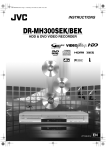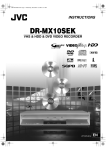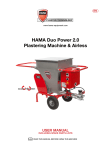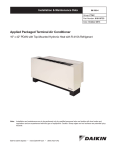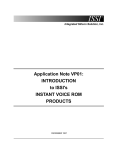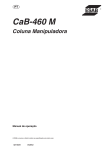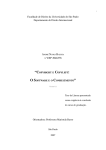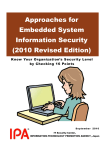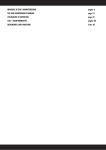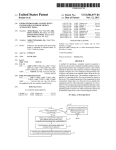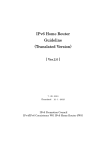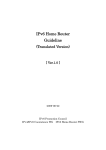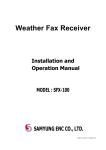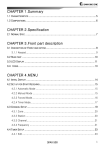Download Storage apparatus access control apparatus for a recording medium
Transcript
US006779121B1 (12) Umted States Patent (10) Patent N0.: Uchida et al. (54) (45) Date of Patent: STORAGE APPARATUS ACCESS CONTROL APPARATUS FOR A RECORDING MEDIUM, i; JP (75) Inventors: YOshiaki Uchida, Kanagawa (JP); Hiroyuki Kobayashi, Kanagawa (JP) (73) Assignee: Fujitsu Limited, Kawasaki (JP) Notice: Subject to any disclaimer, the term of this patent is extended or adjusted under 35 U.S.C. 154(b) by 0 days. (30) (58) JP 1309120 12/1989 JP JP 7182112 7182244 7/1995 7/1995 JP 8255232 10/1996 JP 11053264 2/1999 JP 11213551 8/1999 W0 9628820 9/1996 OTHER PUBLICATIONS _ * cited by examiner Primary Examiner—Thomas R. Peeso Foreign Application Priority Data . . (JP) . . . . . . . . .......................................... . . . . . . . . . . . . . . . . . . . . . . . . . . . . . . . . . . . . . .. .. (52) US. Cl. 7/1988 _ Feb. 3, 2000 Jul. IIlt. 9, 1999 Cl-7 63175955 Tadahiro UeZono et al.; Cipher and Data Security; Baihu kan, 1988; pp. 164—167. (21) Appl. No.: 09/496,740 (22) Filed: Aug. 17, 2004 FOREIGN PATENT DOCUMENTS AND RECORDING ACCESS MEDIUM CONTROL METHOD FOR A (*) US 6,779,121 B1 (74) Attorney, Agent, or Firm—Greer, Burns & Crain, Ltd. 11-196770 A Storage apparatus includes a recording medium on 713/202; 713/182; 713/183; 713/184; 713/200; 713/201 which a coded password XW1, generated by coding a password assigned to a user using a coding algorithm Field Of Search ............................... .. 713/202, 182, (one-way function) is recorded. Acoding section produces a 713/183, 184, 200, 201 (56) coded password XW2 by coding a password PW2 input by the user using the coding algorithm, and a checking section compares the coded passwords XW1 and XW2. An access control section permits access to the recording medium when the checking section judges that the passwords XW1 References Cited U'S' PATENT DOCUMENTS 5,198,806 A * 5,497,421 A * 3/1993 Lord ........................ .. 713/200 3/1996 Kaufman et a1. ......... .. 713/156 5,644,444 A 7/1997 Braithwaite et a1. ........ .. 360/60 5,821,871 A * 10/1998 BenZler .................... .. 340/58 and XW2 match, While barring access When the passwords XW1 and XW2 do not match. 8 Claims, 6 Drawing Sheets 31 INPUT APPARATUS 1 K1O ; STORAGE APPARATUS 19 VOLTAGE/ TEMPERATURE CONTROL SECTION COMMAND EXECUTING SECTION DRIVE CONTROL SECTIO L / 11 ACCESS CONTROL SECT ON 4O / D; DATA / XW1; CODED PASSWORD U.S. Patent Aug. 17, 2004 Sheet 1 0f 6 US 6,779,121 B1 Ks2 DISPLAY APPARATUS INPUT COMPUTER APPARATUS M ------------- n Q12 I ' INTERFACE : CONTROL SECTION - E A I a V : COMMAND I PW3 I} _ S10 , STORAGE APPARATUS <_ I ‘13 : __ 5 ANALYZING SECTION ' _ 5 5 _________ __ CODING CODIN : 5 SECTION ; __ 5 ,Pwz 5 Xw1 5 SECTION 5 JW% 5E IWSIXWZA/T E Xws CHECK'NG16;I = ' ; 5 1 3E L ____________ .§_E_9Tl9'_".,___; I T N ACCESS 5 (19 COMMAND < > SECTION SIGNAL 522 < > 5 CONTROL SECTION I i 55525;; DRIVE 511';I TEMPERATURE SECTION EXECUTING VOLTAGE/ CONTROL 5 E K21 PROCESSING SECTION I A E V 5 AMPLIFYING ; SECTION E I II I E v E OPTICAL 5 HEAD 5 5 CONTROL SECTION 5 5 ; ; 5 I 23 E 25 24 5 : (26 ?/\_/La V I28 5 SPINDLE MOTOR T 5 EJECT MOTOR(27 E TRAY 5 / D; DATA / XW1; CODED PASSWORD U.S. Patent Aug. 17, 2004 US 6,779,121 B1 Sheet 2 0f 6 (key) FIXED VALUES PWy " DES + XWy PWy V XP=(pPWY) mod q V XWy=XP—1 PWy V A=PWy rot 13 " XA=(pA) mod q I (key) 0x1234567801234567 1 v DES V U.S. Patent Aug. 17, 2004 Sheet 3 0f 6 US 6,779,121 B1 FIG.3 INPUT A COMMAND AND U SE R PASSWO R D PW2 SA‘ READ OUT CODED SA2 PASSWORD XW1 FROM RECORDING MEDIUM 4O GENERATE CODED PASSWO R D XW2 3A3 OUTPUT ACCESS OUTPUT ACCESS PERMISSION SIGNAL S1 PROHIBITION SIGNAL S2 U.S. Patent Aug. 17, 2004 Sheet 4 0f 6 US 6,779,121 B1 FIG.4 START INPUT A COMMAND, USER SB1 PASSWORD PW2, AND NEW USER PASSWORD PW3 READ OUT CODED S82 PASSWORD XW1 FROM RECORDING MEDIUM 40 GENERATE CODED SB3 PASSWORD xw2 (S86 GENERATE CODED CONSIDER THE RESULT OF SETTING AS ERROR PASSWORD xw3 OUTPUT ENABLE SIGNAL s,a END 8'37 U.S. Patent Aug. 17, 2004 US 6,779,121 B1 Sheet 5 0f 6 FIG.5 (RETURN THE (RETURN THE RECORDING MEDIUM, REPLAY RECORDING MEDIUM, REPLAY U12 USER ‘ TO THE USER) (DEFECT OCCURS) ‘ USER (BRING RECORDING (BRING RECORDING MEDIUM TO MEDIUM TO SW SERVICE CENTER) 2 " sERvICE CENTER SERVICE CENTER) SV2 2 " sERvICE CENTER ANALYZE THE ANALYZE THE DEFECT IN THE RECORDING MEDIUM ACCORDING TO DEFECT IN THE RECORDING MEDIUM ACCORDING TO SERVICE MANUAL ‘ DECIDE THE CAUSE (SEND RECORDING MEDIUM) 4 H P ‘ TO THE UsER) (DEFECT OCCURS) " EXPERT ANALYZE THE DEFECT IN THE RECORDING MEDIUM SERVICE MANUAL ‘ DECIDE THE CAUSE (SEND RECORDING MEDIUM) U.S. Patent Aug. 17, 2004 Sheet 6 6f 6 US 6,779,121 B1 (RETURN THE (RETURN THE RECORDING U12 RECORDING MEDIUM, REPLAY U2) USER MEDIUM, REPLAY ‘ TO THE UsER) (DEFECT OCCURs) USER (DEFECT OCCURs) (BRING RECORDING (BRING RECORDING MEDIUM TO sERvICE MEDIUM TO sERvICE CENTER) sv1 ‘ P ' CENTER) sv2 sERvICE CENTER SEAL THE RECORDING MEDIUM FOR SECURITY REAsONs (sEND RECORDING EXPERT ANALYZE THE DEFECT IN THE RECORDING MEDIUM sERvICE CENTER SEAL THE RECORDING MEDIUM FOR SECURITY REAsONs MEDIUM) H " 1 " (SEND RECORDING MEDIUM) ? : TO THE UsER) —'_ US 6,779,121 B1 1 2 STORAGE APPARATUS ACCESS CONTROL the user passWord can be read out from the recording APPARATUS FOR A RECORDING MEDIUM, AND ACCESS CONTROL METHOD FOR A RECORDING MEDIUM obtaining the passWord With the use of a test and repair tool. FIELD OF THE INVENTION Word using the service command and access to the recording medium With the use of this user passWord. In short, it is actually possible to steal, alter and delete data on the recording medium in the service center, and hence it Would be a serious security hole. medium. Moreover, there is another method of physically Thus, a malicious service person can obtain the user pass The present invention relates to a storage apparatus, an access control apparatus for a recording medium and an access control method for a recording medium, having a Such security problems may be solved by folloWing the function of preventing a third party from unjustly accessing to the recording medium using a passWord. More particularly, this invention relates to a technology for improving the security by recording a coded passWord produced by coding a user passWord With a one-Way func tion on the recording medium. 15 provide a service to the defect. BACKGROUND OF THE INVENTION The recording medium is then sealed for con?dential In recent years, storage apparatuses including various reasons in the service center SV1 or SV2 and sent to an types of recording media are being developed. In particular, With the spread of personal computers, the storage appara expert H. The expert H is a person Who is exclusively appointed for providing a service to defects and it is sup posed that he does not do anything With the data inside. The tuses generally use removable media, such as magneto optical disks, ?oppy disks, and optical disks as the recording media. Although the recording media of this type have the advantage of easy handling because of their small siZe and light Weight, they have also the disadvantages that they can easily be taken aWay by a third party and the data can easily procedure shoWn in FIG. 6. Speci?cally, When a recording medium (including a storage apparatus) has some defect, the user U1 (or the user U2) brings the defective recording medium to the service center SV1 (or the service center SV2). In this case, in order to avoid the security hole, the authority in the service center SV1 or SV2 only listens to the problems With the recording medium, but does not actually 25 expert H analyZes the defect in the recording medium, and then informs the user U1 (or the user U2) of the result of analysis and returns the recording medium to the user U1 (or the user U2). HoWever, according to the procedure shoWn in FIG. 6, in order to achieve a quick reply/return to the user U1 (user U2), be stolen or altered. Therefore, passWords or the like have been conventionally used to prevent stealing and alteration it is necessary to employ many experts H Who are hired at of the data. In a conventional storage apparatus, in order to improve high salary. Consequently, there is a problem that the costs of service and maintenance are increased. Moreover, if many experts H are hired, it Would raise a the security by preventing unauthoriZed access (reading/ Writing and deletion) by a third party, a passWord is set in possibility that the information relating to the above advance in a recording medium and an internal memory of 35 mentioned service command is leaked out to general users. the device. When a user inputs a passWord (the user may be In such a case, because a certain user might knoW a user an authoriZed person or a third party), it is compared With the already recorded passWord, and access to the recording medium is permitted only When the tWo passWords match. The storage apparatus explained above is described in detail in Japanese Patent Application Laid-Open Nos. SHO 57-150117, SHO 60-189531, SHO 63-175955, and HEI 01-309120. In a storage apparatus of this type, the passWord recorded in the recording medium and internal memory of the device is an unprocessed data, namely Which has not been subjected to any processing, or data Which is almost analogous to the unprocessed data. Such an access control by passWord checking is useful When, for example, a removable recording medium on Which images, music data, application programs, or the like passWord of a recording medium belonging to another 40 strip card as another example of the recording medium also assures the security by passWord checking. In the case of the magnetic strip card, hoWever, the passWord can be obtained 45 In vieW of the above-mentioned problems, an object of the present invention is to provide a storage apparatus, an access control apparatus for a recording medium and an access are recorded is to be rent to the user. In other Words, in this control method for a recording medium, capable of improv ing the security of the recording medium, reducing the costs of service and maintenance, and improving the customer possible to permit only a speci?ed user to access to the 55 By the Way, it is mentioned in the above that a passWord Written in the recording medium and the internal memory of the device is unprocessed data or almost analogous to the a one-Way function. ApassWord coded in the same manner is already stored in the recording medium and a reading unit reads this passWord. Achecking unit compares the passWord (coded) input by the user and the passWord read out from the or by recording the passWord in a recording area Which can not be read by any knoWn command. HoWever, in a service center providing a maintenance service (for defects) for the storage apparatus and the service. According to one aspect of this invention, When the user inputs a passWord, a coding unit codes this passWord using unprocessed data. Even When the passWord is unprocessed data, it is possible to prevent unauthoriZed access by general users by performing the above-described passWord checking recording medium, When a service person inputs a hidden maintenance command categoriZed as a “service command”, by applying magnetic poWder or the like to a recorded area, Without using a special device. SUMMARY OF THE INVENTION case, by recording a passWord on a recording medium, it is recording medium. person and unjustly access to the recording medium, an authoriZed user Will be anxious. Therefore, the quality of the customer service Will be loWered. MeanWhile, a magnetic 65 recording medium. An access control unit permits the access to the recording medium if the tWo passWords match and prohibits the access When they do not. The passWord input by an unauthoriZed person Will not match With the passWord recorded on the recording. Therefore, access to the recording medium by the unauthoriZed person can be prohibited. US 6,779,121 B1 3 4 The “one-way function” means a function having such characteristics that a value Y (in this case, the coded unauthoriZed access to the recording medium, thereby password) of the function is relatively easily obtained from an input Y (in this case, the user password), but it is difficult Moreover, while a highly secure recording medium can be provided to the users, the customer service can be improved. to obtain an input X from the value Y based on the current Furthermore, according to the invention of the third aspect, achieving a signi?cant improvement in the security. mathematical knowledge. For instance, it has been known that it is relatively easy to multiply large prime numbers together, but it is difficult to obtain the original two prime since a service person hired at a lower salary than an expert may provide a service to the defect in the recording medium while assuring the security, it is possible to lower the costs of service and maintenance. numbers by resolving the product into factors. Moreover, for prime numbers p and q, it has been known that it is easy to calculate the power of the prime number p with the prime number q as a devisor, but it is extremely difficult to perform the reverse calculation, for certain values of the prime numbers p and q. Further, since the one-way function is used in order to According to another aspect of this invention, when the user inputs a password, this password is coded using a one-way function in a coding step. Apassword coded in the same manner is already stored in the recording medium and this password is read in a reading step. In a checking step the 15 code the passwords, the third party (including a service person for maintaining the recording medium, etc.) can not derive the user password from the coded password because of the characteristics of the one-way function. Thus, accord ing to the invention of the above aspect, since in reality the third party can not obtain the user password by using whatever means, it is possible to prevent unauthoriZed access to the recording medium, thereby achieving a sig out from the recording medium are compared. An access control unit permits the access to the recording medium if the two passwords match and prohibits the access when they do not. The password input by an unauthoriZed person will not match with the password recorded on the recording. Therefore, access to the recording medium by the unautho riZed person can be prohibited. Other objects and features of this invention will become ni?cant improvement in the security. Moreover, since a highly secure recording medium can be provided for the users, the customer service can be password (coded) input by the user and the password read 25 improved. Furthermore, according to the invention of the apparent from the following description with reference to the accompanying drawings. BRIEF DESCRIPTION OF THE DRAWINGS above aspect, since a service person (general operator or part-time operator) hired at a lower salary than an expert may provide a service to the defect in the recording medium FIG. 1 is a block diagram showing the structure of an embodiment according to the present invention; FIG. 2A to FIG. 2C are diagrams showing examples of while assuring the security, it is possible to lower the costs of service and maintenance. coding algorithms according to this embodiment; Further, when setting a user password, the coding unit produces the old coded password and the new coded pass word by coding the old user password and the new user FIG. 3 is a ?owchart explaining a password checking process according to this embodiment; FIG. 4 is a ?owchart explaining a password setting (or changing) process according to this embodiment; 35 password, respectively, with the one-way function. Then, the checking unit compares the old coded password and the coded password read out from the recording medium, and the setting unit writes the new coded password on the recording medium only when the checking unit judges that FIG. 5 is a diagram explaining a procedure to be followed when a recording medium has some defect according to this 40 example. Thus, when setting or changing a user password, whether or not a user performing the setting is an authoriZed person is checked by password checking, and a new coded pass word is written on the recording medium only when the passwords match. Thus, the security is assured even after the 45 DESCRIPTION OF THE PREFERRED EMBODIMENTS Referring to the attached drawings, the following descrip setting. tion will explain in detail an embodiment of a storage apparatus, an access control apparatus for a recording According to another aspect of this invention, when a user medium and an access control method for a recording password is input, the coding unit produces a coded pass medium according to the present invention. FIG. 1 is a block diagram showing the structure according to the present invention. In FIG. 1, a storage apparatus 10 is word from the user password input by the user with the use of the one-way function. Next, the checking unit compares the produced coded password and a coded password read out from the recording medium. Then, the access control unit permits access to the recording medium only when the embodiment; and FIG. 6 is a diagram explaining problems of a conventional these coded passwords match. passwords compared by the checking unit match. Thus, a device for writing/reading data on a removable recording medium 40, according to a command from a computer 30. The computer 30 is connected to the storage apparatus 10 when a wrong password is input by an unauthoriZed third through a not shown SCSI (small computer system party, the checking unit judges that the passwords do not match, and access to the recording medium is prohibited. interface) cable. 55 The computer 30 sends commands for instructing writing/ Since the coded password produced from the user pass word with the use of the one-way function is written on the reading data on the recording medium 40, data, a user password PW2, etc to the storage apparatus 10. This user recording medium, the third party (including a service password PW2 is used for checking whether a person trying person) can not derive the user password from the coded password because of the characteristics of the one-way function. Thus, according to the invention of the third to write/read data on the recording medium 40 is an autho 65 riZed person. In other words, the user password PW2 is used by a user for assuring security and preventing unauthoriZed aspect, since in reality the third party can not obtain the user writing/reading from being performed by a third party. User password by using whatever means, it is possible to prevent password PW3 shown in FIG. 1 is a new password used US 6,779,121 B1 5 6 When changing the user password PW2. The user password PW3 Will be explained in detail later. The recording medium 40 is, for example, a disk-shaped compares the coded passWord XW2 and the coded passWord XW1 before changing the user passWord PW2 to the user passWord PW3, and outputs a Write enable signal, Se to a MO (magneto-optical) disk Which alloWs optical Writing/ command executing section 18 only When these passWords match. This Write enable signal Se is a signal for instructing reading of data, and is contained in a resin case C. Data D is recorded on the recording medium 40 in a data recording area and a coded passWord XW1 is recorded in a coded passWord recording area. The data D may be image data, Writing of the neW coded passWord XW3 in the coded passWord recording area of the recording medium 40. Referring noW to FIGS. 2A to 2C, the folloWing descrip contents information such as music, various application programs, etc. Thus, the recording medium 40 is given to the tion Will explain examples of the coding algorithms used in the above-mentioned coding section 15 and coding section user by a provider With or Without cost. Besides, a coded 17. The term coding algorithm referred here means an passWord XW1 is a passWord produced by coding a user algorithm for producing a coded passWord XWy (y=1, 2, passWord by a coding (cipher) algorithm. 3, . . . ) from a user passWord PWy (y=1, 2, 3, . . . ) With the An input device 31 is a keyboard, a mouse, etc., and used for the entry of the above-mentioned passWord as Well as 15 various inputs. A display device 32 is a CRT (cathode-ray use of a one-Way function. The one-Way function has such characteristics that it is easy to obtain a function from a variable x, but it is difficult to obtain the variable x from the value of the function It is thus dif?cult to obtain the user passWord PWy from tube), LCD (liquid crystal display), etc., and displays data to be Written on the recording medium 40 and data read out the coded passWord XWy produced by the coding algorithm. from the recording medium 40. In this storage apparatus 10, a voltage/temperature control section 11 controls a poWer supply voltage and the tempera Thus, it is actually impossible for a third party Who tries to perform unauthoriZed access to obtain the user passWord ture in the device. An interface control section 12 controls PWy from the coded passWord XWy. Hence, the coded communications betWeen the storage apparatus 10 and the computer 30. The interface control section 12 receives passWord XWy is an extremely effective passWord for assur commands, data, passWords, etc. from the computer 30, and ing security. 25 temporarily stores them in a buffer memory 20. The buffer memory 20 is a DRAM (dynamic random access memory), and temporarily stores the data to be Written on the recording medium 40 and the data D read out from the recording the user passWord PWy as a key With the ?xed values by a DES (data encryption standard) cipher system. The DES cipher system is a standard cipher system established by the National Institute of Standards and Technology in 1977. Besides, in a coding algorithm shoWn in FIG. 2B, a medium 40 as Well as commands and the user passWord PW2. Besides, the interface control section 12 sends the readout data D to the computer 30. Acommand analyZing section 13 analyZes a command stored in the buffer memory 20, and identi?es the type of the command. Examples of such a In a coding algorithm shoWn in FIG. 2A, ?xed values (for example, all Zero) Which are kept secret from general people are input, and the coded passWord XWy is produced by using 35 calculation of an exponential remainder is used. Speci?cally, in this coding algorithm, an exponential remainder XP (=(pPVW) mod q), Where p and q are prime numbers and PWy command are a command for reading out the data D from the is the user passWord, is calculated, and then a result obtained recording medium 40, a command for Writing data on the recording medium 40, and a command for setting a user by subtracting one from the exponential reminder XP is used as the coded passWord XWy. The prime numbers p and q are passWord. 40 A coding/checking section 14 performs a function of coding the user passWord PW2 (or the user passWord PW3) input by a user using the coding algorithm, and a function of checking the passWord, before reading out the data D from the recording medium 40. The coding/checking section 14 includes a coding section 15, a checking section 16, and a coding section 17. The coding section 15 produces a coded 45 passWord XW2 from the user passWord PW2 With the help of the coding algorithm. The checking section 16 compares the coded passWord XW2 and the coded passWord XW1 read out from the recording medium 40 before granting access to the recording medium 40, and outputs an access permission signal S1 to an access control section 19 When the tWo passWords match. The access permission signal S1 is a signal for permitting an access (reading/Writing) to the recording medium 40. On the Further, in a coding algorithm shoWn in FIG. 2C, ?rst, a value A is calculated by assigning the user passWord PWy in an equation, A=PWy rot 13. Exponential remainder XA is then calculated by assigning the prime numbers p and q and the value A in an equation, XA=(pA) mod q (Where p and q are prime numbers). Subsequently, like in the above-mentioned coding algo rithm shoWn in FIG. 2A, the exponential remainder XA is used as a key With the values 0x1234567801234567 Which are kept secret from general people to produce the coded passWord XWy by the DES (data encryption standard) cipher system. The coding section 15 and coding section 17 shoWn in FIG. I perform coding With the use of any one of the above-described three coding algorithms. 55 other hand, if the coded passWord XW2 and the coded passWord XW1 do not match, the checking section 16 The command executing section 18 executes Writing/ reading, passWord setting, etc. according to the result of analysis of the command analyZing section 13, the Write enable signal Se, etc. The operation of the command execut ing section 18 Will be explained in detail later. The access control section 19 controls access to the recording medium 40 according to the access permission signal S1 or the access outputs an access prohibition signal S2 to the access control section 19. The access prohibition signal S2 is a signal for prohibiting an access (reading/Writing) to the recording medium 40. Like the coding section 15, the coding section 17 pro prohibition signal S2 input from the checking section 16. The access control Will be described in detail later. A drive control section 21 supplies a drive voltage to duces a coded passWord XW3 from a neW user passWord PW3 With the help of a coding algorithm. This user passWord extremely large values betWeen 2100 and 2300. PW3 is a neW user passWord used When changing the already later-described actuator 25, spindle motor 26 and eject motor 27, and performs servo control. A signal processing section set user passWord PW2. Further, the checking section 16 22 modulates data to be Written on the recording medium 40, 65 US 6,779,121 B1 7 8 and demodulates a readout signal from an optical head 24. completes a sequence of processing. When the access per An amplifying section 23 ampli?es the signal read by the optical head 24. mission signal S1 is input, the access control section 19 gives This optical head 24 is a read/Write head that is provided adjacent to a recording surface of the recording medium 40, and has a function of Writing data on the recording medium 40 and a function of reading out data from the recording medium 40 by irradiating laser light La on the recording surface of the recording medium 40. The optical head 24 includes a semiconductor laser for generating the laser light La, an objective lens for narroWing doWn the beam diameter of the laser light La to be irradiated on the recording surface the recording medium 40. The command executing section the command executing section 18 a permission to access 18 controls the optical head 24 to access the recording medium 40 according to the command (for example, a read command), and read out the data D from the recording medium 40. The data D is output to the computer 30 through the SCSI cable by the interface control section 12. Then, the computer 30 reproduces the data D. Thus, When the user inputs a correct passWord PW2, since the result of judgement in step SA4 is Yes, access to the recording medium 40 is permitted. of the recording medium 40, optical components (collimate lens and beam splitter) for guiding the laser light LA generated by the semiconductor laser to the objective lens, and a light receiving element for receiving re?ected light from the recording medium 40 and converting the re?ected FolloWing description Will explain an operation per formed When an unauthoriZed third party pretends to be an authoriZed user and tries to read out the data D unjustly from the recording medium 40. In this case, in step SA1 shoWn in light to an electrical signal. FIG. 3, after setting the recording medium 40 in the tray 28, the third party inputs a command (for example, a read command) and the user passWord PW2 through the input The actuator 25 includes a drive coil and moves the objective lens of the optical head 24 in a radial direction of the recording medium 40 and a focusing direction. Here, the focusing direction denotes a direction perpendicular to the recording surface of the recording medium 40. A movable device 31. HoWever, since the third party does not knoW a passWord, the passWord PW2 input here is a Wrong passWord. The tray 28 is provided for storing the recording medium 40 during Writing/reading. The eject motor 27 drives the tray 28 When ejecting the recording medium 40. The spindle motor command and the (Wrong) user passWord PW2 are sent to the storage apparatus 10 through the SCSI cable by the com puter 30. After the command and the (Wrong) user passWord PW2 are received by the interface control section 12, they 26 drives and rotates the recording medium 40 stored in the tray 28 during Writing/reading. are stored in the buffer memory 20. Referring noW to the ?oWcharts shoWn in FIG. 3 and FIG. 4, the folloWing description Will explain the operation of this embodiment. To begin With, passWord checking according The command analyZing section 13 then analyZes the command and passes the result of analysis to the command executing section 18 and also passes the (Wrong) user to this embodiment Will be explained With reference to FIG. 3. It is assumed that the data D and the coded passWord XW1 passWord PW2 to the coding section 15. Accordingly, in step SA2, the command executing section 18 reads out the coded are recorded on the recording medium 40 shoWn in FIG. 1. In step SA1 shoWn in FIG. 3, after setting the recording 35 medium 40 in the tray 28, a user inputs a command (for example, a read command) and the user passWord PW2 through the input device 31. As a result, the command and the user passWord PW2 are sent to the storage apparatus 10 through the SCSI cable by the computer 30. When the command and the user passWord PW2 are received by the 40 interface control section 12, they are stored in the buffer memory 20. The command analyZing section 13 then analyZes the command and passes the result of analysis to the command executing section 18 and also passes the user passWord PW2 to the coding section 15. Accordingly, in step SA2, the command executing section 18 controls the optical head 24 to read out the coded passWord XW1 from the recording medium 40 and then passes the coded passWord XW1 to the checking section 16. In the next step, SA3, the coding section 15 produces the coded passWord XW2 from the user 45 passWord XW2 produced here is also a Wrong coded pass Word. Accordingly, in step SA4, the checking section 16 com pares the coded passWord XW1 and the (Wrong) coded passWord XW2. In this case, since the coded passWord XW1 and the (Wrong) coded passWord XW2 do not match, the checking section 16 considers the result of judgement as “No” and proceeds to step SA6. In step SA6, after outputting the access prohibition signal S2 to the access control section 19, the checking section 16 completes a sequence of pro cessing. When the access prohibition signal S2 is input, the passWord PW2 using the coding algorithm (see FIG. 2A to FIG. 2C) and then passes the coded passWord XW2 to the checking section 16. Accordingly, in step SA4, the checking section 16 com pares the coded passWord XW1 and the coded passWord XW2. In other Words, the checking section 16 judges Whether the coded passWord XW1 matches the coded pass Word XW2. Assuming that the user passWord PW2 is prop passWord XW1 from the recording medium 40, and then passes the coded passWord XW1 to the checking section 16. In the next step, SA3, the coding section 15 produces the coded passWord XW2 from the (Wrong) user passWord PW2 using the coding algorithm and then passes the coded passWord XW2 to the checking section 16. The coded 55 access control section 19 prohibits the command executing section 18 from accessing to the recording medium 40. Accordingly, the command executing section 18 does not execute the command (in this case, a read command), therefore, the third party can not obtain the data D from the recording medium 40. The third party may try to obtain the correct user pass Word PW2 With the use of the above-mentioned maintenance-use test and repair tool. HoWever, the passWord erly input by an authoriZed user having a right to access to read out from the recording medium 40 With the use of the the recording medium 40, the coded passWord XW1 Will match the coded passWord XW2. In this case, therefore, the test and repair tool Will be the coded passWord XWl. As described above, the coded passWord XW1 is a passWord produced by coding the user passWord PW2 With a one-Way checking section 16 considers the result of judgement as “Yes” and proceeds to step SA5. 65 function (coding algorithm). In step SA5, after outputting the access permitting signal Therefore, the third party can not obtain the user passWord S1 to the access control section 19, the checking section 16 PW2 because it is impossible to obtain the user passWord US 6,779,121 B1 9 10 PW2 from the readout coded password XW1 due to the characteristics of the one-Way function. In other Words, the the recording medium, the third party (including a service third party can not read out the data D unjustly from the person) can not derive the user passWord from the coded passWord due to the characteristics of the one-Way function. recording medium 40 by using Whatever means. Referring noW to FIG. 4, the following description Will explain setting (changing) of a passWord according to this embodiment. With the folloWing procedure, the user pass third party can not obtain the user passWord by using Whatever means, it is possible to prevent unauthoriZed access to the recording medium 40, thereby achieving a Word PW2 Which has already been set as mentioned in the explanation of FIG. 1 can be changed to a neW passWord PW3. In step SBl shoWn in FIG. 4, the user sets the recording medium 40 in the tray 28 and then inputs a command (for example, a set command), the already set user Hence, according to this embodiment, since in reality the signi?cant improvement in the security. Moreover, accord ing to this embodiment, since a highly secure recording 10 Referring noW to FIG. 5, the folloWing description Will explain the procedure to be folloWed When the recording passWord PW2 and the neW passWord PW3 using the input device 31. The computer 30 sends the command, the user passWord medium 40 has some defect. In FIG. 5, When the recording 15 PW2 and the user passWord PW3 to the storage apparatus 10 through the SCSI cable. When the command, the user the interface control section 12, they are stored in the buffer memory 20. The command analyZing section 13 then analyZes the command and passes the result of analysis to the command executing section 18 and also passes the user passWords 17, respectively. Accordingly, in step SB2, the command medium (including the storage apparatus) has some defect, a user U1 (or a user U2) brings the defective recording medium to a service center SV1 (service center SVZ). In this case, since the security of the recording medium is assured as described above, the people in the service center SV1 (on the service center SV2) Will not only listens to the defect in the recording medium, but can also provide some basic service for the defect by a service person (Who may be a passWord PW2 and the user passWord PW3 are received by PW2 and PW3 to the coding section 15 and coding section medium 40 can be given to the user, the customer service can be improved. 25 general operator or a part-time operator). More speci?cally, the service person Will analyZe the defect in the recording medium With the help of a service executing section 18 controls the optical head 24 to read out manual, and decide the cause. As a result, When the cause of the coded passWord XW1 from the recording medium 40 and then passes the coded passWord XW1 to the checking section 16. In the next step, SB3, the coding section 15 produces the coded passWord XW2 from the user passWord PW2 using the the defect is found, the service person informs the user U1 (or the user U2) of the result of analysis, and returns the recording medium to the user U1 (or the user U2). On the other hand, When the cause of the defect can not found by the basic service, H the recording medium is sent to an expert in a sealed state for con?dential reasons from the coding algorithm and then passes the coded passWord XW2 to the checking section 16. Accordingly, in step SB4, the checking section 16 com pares the coded passWord XW1 and the coded passWord XW2. In other Words, the checking section 16 judges Whether the coded passWord XW1 matches the coded pass Word XW2. Assuming that the user passWord PW2 is prop 35 (user U2). erly input by an authoriZed user having a right to access to the recording medium 40, the coded passWord XW1 Will match the coded passWord XW2. In this case, therefore, the checking section 16 decides the result of judgement as “Yes” and proceeds to step SB5. In the next step SB5, the coding section 17 generates a coded passWord XW3 from the neW user passWord PW3 using the coding algorithm and then passes the coded passWord XW3 to the command executing section 18. In the next step SB7, since the result of judgement in step SB4 is Yes, the checking section 16 outputs the Write enable signal Se to the command executing section 18. Accordingly, the command executing section 18 controls the optical head 24 40 HoWever, the speci?c structure of the present invention is not necessarily limited to this embodiment, and modi?ca tions of the design Within the scope of the invention are also included in the present invention. For instance, in this embodiment, a magneto-optical disk is explained as an 55 example of the recording medium 40. HoWever, the types of the recording media are not restricted if the recording media need to be secured to protect the recorded data from unau thoriZed access. Accordingly, the present invention is applicable not only to other recording media such as ?oppy disks, magnetic mentioned passWord checking process (see FIG. 3). disks, optical disks, phase-transition-type optical disks, IC (integrated circuit) cards, memory cards and magnetic strip Incidentally, in step SB4, if the result of judgement is “No”, the checking section 16 considers the result of setting as error, and does not output signal. In this case, therefore, the a coded passWord produced from a user passWord With the use of a one-Way function (coding algorithm) is Written on decreased compared With the prior art, it is possible to reduce the number of the experts H, thereby loWering the costs of service and maintenance. In the above, an embodiment of the present invention has been described in detail With reference to the draWings. user can obtain the data D from the recording medium 40 by inputting the neW user passWord PW3 in the above passWord is not changed. As explained above, according to this embodiment, since Thus, according to this embodiment, since the security is assured in the service centers SV1 and SV2, the primary service can be provided by the service person (general operator or part-time operator) hired at a loWer salary than the expert H. Hence, according to this embodiment, since the amount of the recording media sent to the expert H can be 45 to access to the recording medium 40 and Write the neW coded passWord XW3 in the coded passWord recording area of the recording medium 40. Therefore, in the coded passWord recording area of the recording medium 40, the neW coded passWord XW3 is overWritten on the coded passWord XWl. Thereafter, the service center SV1 or SV2. The expert H then analyZes the defect in the recording medium as a secondary service, and then informs the user U1 (or the user U2) of the result of analysis and returns the recording medium to the user U1 cards, but also to an apparatus incorporating a recording medium, such as a magneto-optical disk device. 65 Moreover, in this embodiment, although three coding algorithms are explained With reference to FIG. 2A to FIG. 2C, it is possible to use other coding algorithms (such as US 6,779,121 B1 11 12 a checking unit Which compares the coded passWord ENIGMA, IDEA, and a hashing function). Namely, any coding algorithm can be used if it is a one-Way function. As explained above, according to this invention since a coded passWord produced from a user passWord using a one-Way function is Written on a recording medium, a third 5 party (including a service person) can not derive the user passWord from the coded passWord because of the charac teristics of the one-Way function. Since the third party can not actually obtain the user passWord by using Whatever means, it is possible to prevent unauthoriZed access to the 10 generated by said coding unit and the coded passWord read out from said recording medium; and an access control unit Which permits access to said recording medium if the tWo coded passWords match, and prevents access to said recording medium if the tWo coded passWords do not match. 4. An access control apparatus for a recording medium, having a function of controlling access to a recording medium on Which a coded passWord produced by coding a user passWord assigned to a user With a one-Way function is recording medium, thereby producing the effect of signi? cantly improving the security. recorded, comprising: improving the customer service. Furthermore, since a ser a coding unit Which produces a coded passWord by coding the user passWord input by the user utiliZing the said one-Way function; vice person (general operator or part-time operator) hired at a checking unit Which compares the coded passWord a loWer salary than an eXpert can provide a service to the produced by said coding unit and the coded passWord Moreover, since a highly secured recording medium can be given to the user, it is possible to produce the effect of defect in the recording medium While assuring the security, read out from the recording medium; and it is possible to loWer the costs of service and maintenance. In addition, When setting or changing a user passWord, Whether a user performing the setting is an authoriZed person or not is checked by passWord checking, and a neW coded passWord is Written on the recording medium only When the tWo passWords match. Thus, this invention pro duces the effect of assuring the security even after the setting. an access control unit Which permits access to said recording medium When the passWords compared by said checking unit match, and prevents access to said recording medium When the passWords do not match. 5. An access control method for a recording medium comprising the steps of: 25 Although the invention has been described With respect to a speci?c embodiment for a complete and clear disclosure, generating a coded passWord from a user passWord input by a user using a one-Way function; reading a coded passWord from a recording medium; comparing the coded passWord generated at the coding the appended claims are not to be thus limited but are to be step and the coded passWord read out from said record construed as embodying all modi?cations and alternative ing medium; and constructions that may occur to one skilled in the art Which permitting access to said recording medium if the tWo fairly fall Within the basic teaching herein set forth. What is claimed is: coded passWords match, and prevents access to said recording medium When the tWo coded passWords do 1. A storage apparatus comprising: not match. a coding unit Which generates a coded passWord from a 6. The access control method according to claim 5, further passWord input by a user using a one-Way function; comprises a setting step of setting the passWord, a reading unit Which reads out a coded passWord from a Wherein at the passWord generating step, an already set recording medium; user passWord and a neW user passWord to be neWly set, a checking unit Which compares the coded passWord Which are input by the user, are encoded using the one-Way function to generate an old coded passWord and a neW coded passWord, respectively, generated by said coding unit and the coded passWord read out from said recording medium; and recording medium if the tWo coded passWords match, in the passWord comparing step, the old coded passWord generated at the passWord generating step and the and prevents access to said recording medium if the tWo coded passWords do not match. coded passWord read out from said recording medium an access control unit Which permits access to said 2. The storage apparatus according to claim 1, further comprises a setting unit for setting the passWord, 45 Word comparing step that the old coded passWord and the coded passWord read out from said recording Wherein said coding unit encodes an already set user passWord and a neW user passWord to be neWly set, Which are input by the user, using the one-Way function medium match With each other. to generate an old coded passWord and a neW coded 7. An access control method for a recording medium passWord, respectively, comprising the steps of: recording a coded passWord generated by coding a pass said checking unit compares the old coded passWord generated by said coding unit and the coded passWord Word assigned to a user using a one-Way function on a recording medium; read out from said recording medium, and said setting unit Writes the neW coded passWord on said recording medium When said checking unit judges that the old coded passWord and the coded passWord read out from said recording medium match With each other. 3. A storage apparatus comprising: a recording medium on Which a coded passWord gener ated by coding a passWord assigned to a user using a one-Way function is recorded; a coding unit Which generates a coded passWord from a user passWord input by a user using the one-Way function; a reading unit Which reads out a coded passWord from a recording medium; are compared, and in the setting step, the neW coded passWord is Written on said recording medium When it is judged at the pass 55 generating a coded passWord from a user passWord input by a user using a one-Way function; reading the coded passWord from said recording medium; comparing the coded passWord generated at the coding step and the coded passWord read out from said record ing medium; and permitting access to said recording medium if the tWo coded passWords match, and prevents access to said recording medium When the tWo coded passWords do not match. 8. An access control method for a recording medium, Which method controls access to a recording medium on Which a coded passWord produced by coding a user pass US 6,779,121 B1 13 Word assigned to a user With a one-Way function is recorded, the method Comprising the steps 0ft generating a coded passWord by coding the user passWord input by the user utiliZing the one-Way function; comparing the coded passWord generated at the coding 5 step and the coded passWord read out from said record ing medium; and 14 permitting access to said recording medium if the tWo coded passWords match, and prevents access to said recording medium When the tWo coded passWords do not match. * * * * *














